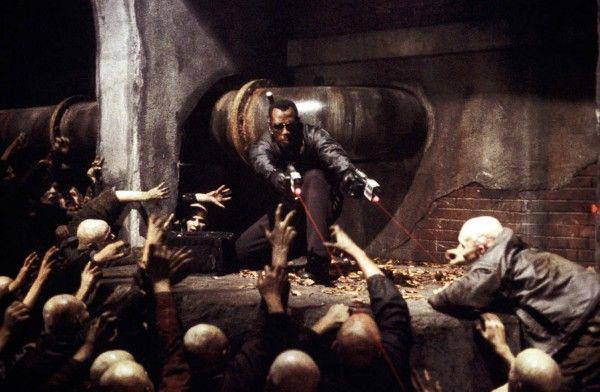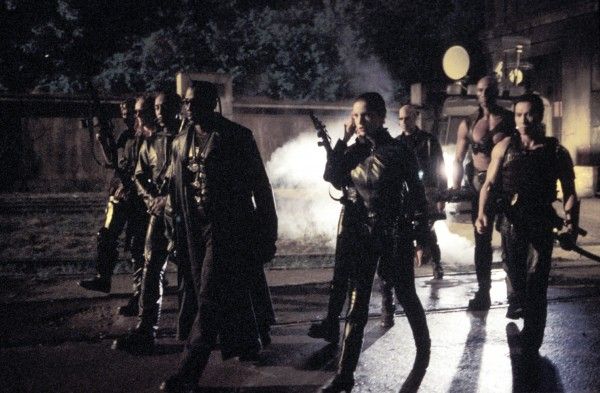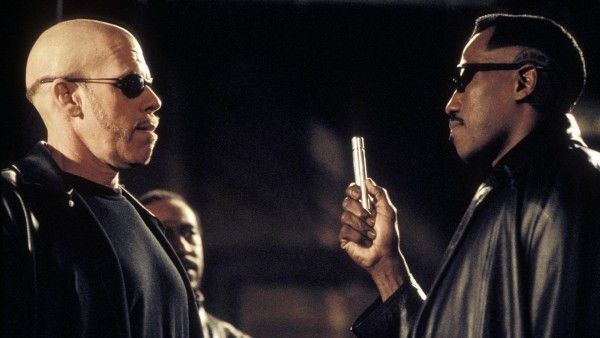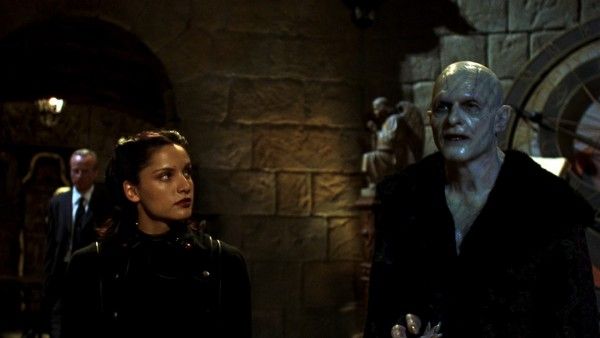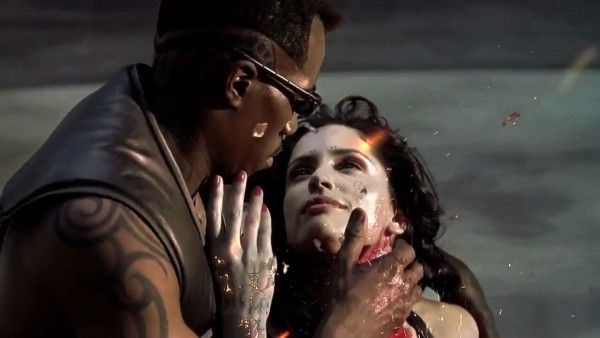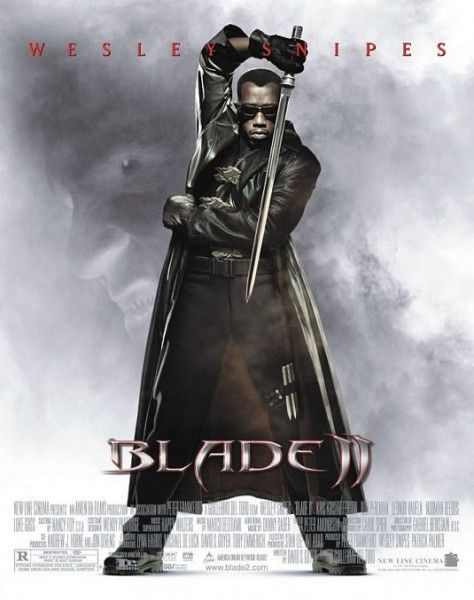[With Guillermo del Toro’s new movie Crimson Peak opening Friday, I decided to take a look back at the director’s filmography.]
If Guillermo del Toro had gone from Mimic to Blade II, the latter would be a weaker film. It’s not just that The Devil’s Backbone gave del Toro experience and confidence. It’s that Blade II also carries the director’s personality to the point where he takes full ownership of an orphan franchise in a genre that still hadn’t fully found a personality. In 2002, the modern superhero genre was still in its nascent stages, and if Blade II were made today, it would probably have to be part of a larger cinematic universe with an eye towards a multitude of sequels and mythology.
As it stands, Blade II breaks apart from Stephen Norrington’s Blade (1998) to become an action-horror flick that happens to be based on a Marvel comic, and features a protagonist whose superpowers require no visual effects work unless you count the CGI stunt doubles. Even though the first movie was a modest hit, del Toro had enough leeway to do a soft reboot, and he infused it with so much of his personality that it feels like the Blade franchise belonged to him all along.
While del Toro was still one movie away from a franchise that encapsulated his true personality (Hellboy), it’s easy to see why he was attracted to Blade since it once again brings him to the struggle of monsters and men. Blade (Wesley Snipes) is a monster—he has the thirst for human blood—but he can walk among men, although humans are rarely glimpsed in this film. The question is how much does Blade want to indulge his monstrous side? He can play the hero and kill vampires all day, but he’ll always be part-vampire, and (in one of the many ways Blade eschews traditional superhero tropes) he has no desire to live a “normal” life. He doesn’t want to be among vampires or humans, which makes him a loner, albeit one who doesn’t have much in the way of inner conflict.
Blade II is an incredibly upbeat picture, and rather than focus on Blade’s loneliness or how he’s humanity’s protector and yet can never truly be one of them, del Toro gleefully jumps into the action scenes. This is the director’s first true action film and he takes to it like a shark to chum-filled water. Although some scenes, like Blade’s fight with Nyssa (Leonor Varela) and Asad (Danny John-Jules) haven’t aged well, the kinetic movement is almost always invigorating, and you can see del Toro trying to accommodate a leading man who loves to do martial arts. To Snipes’ credit, some of his moves are impressive, and then there are other times where the fight choreography demanded someone who could do more than throw a punch or swing a sword.
The plot sends Blade into an uneasy alliance with vampires, specifically the Bloodpack, who were trained to take him down, but now have been re-tasked to stop Jared Nomak (Luke Goss), a new breed of vampire who carries the “reaper strain”, which makes vampires prey alongside humans. Forcing Blade to work with vampires who hate him in order to serve the greater good is a solid setup, and it’s a shame that del Toro and screenwriter David Goyer didn’t do more with it. The most we really get from this relationship is Blade appreciating Nyssa as an individual rather than having to revaluate vampire-kind.
It also makes us somewhat indifferent to the Bloodpack. There’s Vampire with Sword (Donnie Yen), Vampire with Giant Hammer (Daz Crawford), Vampire with Red Hair (Marit Velle Kile), etc. The only one who really stands out is Ron Perlman as Reinhardt, and he’s as despicable at the beginning as he is at the end. Thankfully, it’s Perlman playing the role and he’s absolutely delightful even though Reinhardt is, in addition to being a murderous vampire, totally racist. The fact that Reinhardt’s utterly captivating even though he’s a racist flack speaks to Perlman’s charisma, especially when working with del Toro, and it’s a shame that the rest of the Bloodpack are just fodder for the army of Reapers.
When it comes to the Reapers, you can tell just how much joy del Toro is having with the material, and that Blade is a much better fit for the director than a traditional comic book hero. Blade II lets del Toro again indulge his fascination with vampirism, assert it as a viral strain, and then plunge into the gory designs for the reapers, which were unforgettable. While the Blade franchise was certainly accommodating to del Toro’s style, the Reapers are where he gets to put his clearest mark on the franchise.
The film also provides the pull between the modern and the ancient, a divide where most of del Toro’s work lives. One is always encroaching on the other, and it tends to be a breeding ground for monsters. In the case of Blade II, the film’s true villain isn’t Nomak (whose prodigal son nature feels a bit like the prototype for Hellboy II’s baddie Prince Nuada), but his “father” and the Reaper strain’s creator Damaskinos (Thomas Kretschmann), who, in a bit of a callback to Mimic’s Dr. Susan Tyler, fucks with the natural order of things in order to stay at the top of the food chain. The fact that the “hero” of Mimic and the villain of Blade II have common ground feels like it speaks more to del Toro’s disdain for the former more than his sympathy for the latter.
While science may not necessarily be an “enemy” in del Toro’s movies, tradition and honesty are what’s respected above all else. There’s a lot of sympathy for Nomak even though he’s a “monster”, but he gets an honorable, honest-to-goodness brawl with Blade at the end that almost feels a bit perfunctory. They don’t hate each other, but Nomak wants to survive and Blade needs to save humanity from the Reapers. The ones who get it the worst are Scud (Norman Reedus), Reinhardt, and Damaskinos, who behave in a sneaky, underhanded manner to achieve their goals, and ultimately die in a gruesome manner.
Compare that with the graceful, bright blue light inside of Nomak when he dies, or Nyssa, who is a vampire, doing the most “human” thing one can do in a del Toro film and choosing to die on her own terms by asking to see the sunrise rather than be turned into a Reaper. I’m sure for New Line Cinema, Blade II was just continuing another lucrative superhero franchise and churning out new installments, but this movie undeniably belongs to its director, especially when you compare it to Blade or Blade: Trinity.
However, the Blade franchise could never completely be del Toro’s. It’s not earnest enough or even silly enough because Blade has to be “cool”. Even though it’s about a vampire who hunts other vampires, it’s not a nerdy franchise, and while del Toro had room to explore the ancient side of vampire culture in Blade II, he was still limited by a franchise that demanded hyperactive set pieces and techno music. Blade II could carry the director’s spirit, but his heart was with his next comic book movie.
Tomorrow: Hellboy
Other Entries:


